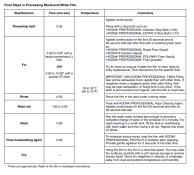Mainecoonmaniac
Member
- Joined
- Dec 10, 2009
- Messages
- 6,297
- Format
- Multi Format
I’ve been processing film the same way for 40 years. Decades ago, when water was more plentiful, I was taught wash in running water for 5 minutes. Now with climate change, this method of washing is not environmentally friendly. There’s the water saving Ilford way. The suggest “fill the tank with water at the same temperature as the processing solution and invert it 5 times. Drain the water away and refill then invert the tank 10 times. Finally, drain and refill the tank again then invert it twenty times before draining.”
How effective is this method?
Thanks for your input!
How effective is this method?
Thanks for your input!












